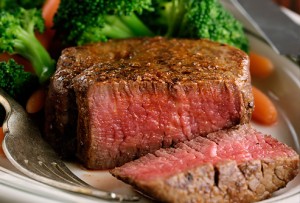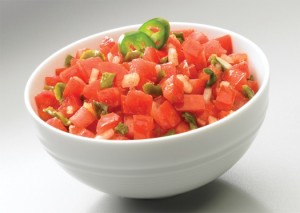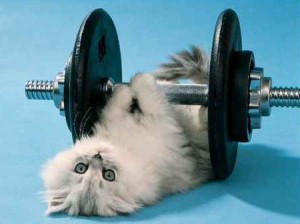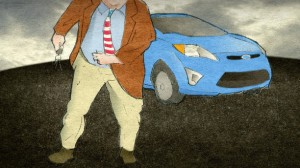September 12, 2015
Quick 30 Minute workout With Carol Strom Saturday 1 of 21 day challenge.
March 26, 2012
The Leanest Cut of All
Is it possible to eat beef on a regular basis and not get beefy in the process? Absolutely, says an article that appeared in a supplement to the October 2005 issue of Tufts University Health & Nutrition Letter. The trick is to select the right cut of beef and to exercise portion control.
Here’s a look at 10 of the leanest cuts, which, according to the National Cattleman’s Beef Association, contain on average only 1 more gram (g) of saturated fat than a skinless chicken breast per 3-ounce serving:
1. eye round (1.4 g saturated fat, 4 g total fat)
2. top round steak (1.6 g saturated fat, 4.6 g total fat)
3. chuck mock tender steak (1.6 g saturated fat, 4.7 g total fat)
4. bottom round (1.7 g saturated fat, 4.9 g total fat)
5. top sirloin (1.9 g saturated fat, 4.9 g total fat)
6. round tip (1.8 g saturated fat, 5.0 g total fat)
7. 95% lean ground beef (2.4 g saturated fat, 5.0 g total fat)
8. brisket (flat half) (1.9 g saturated fat, 5.1 g total fat)
9. shank crosscuts (1.9 g saturated fat, 5.4 g total fat)
10. chuck shoulder roast (1.8 g saturated fat, 5.7 g total fat)
—
original article from IDEA Fitness
March 22, 2012
Hot Salsa Tip
Did you know that salsa has surpassed ketchup as America’s favorite condiment? Salsa can spice up all kinds of bland meals. Stir in a jar of your favorite salsa to add some zing to a pot of kidney, white, pinto, red or black beans; then top with a dollop of sour cream for a unique, high-fiber side dish.
March 21, 2012
How to Stop Yourself Eating from Boredom
 People who struggle with their weight are often prone to “emotional eating”, consuming food as a response to mental triggers rather than physical hunger. Often, dieters fail to lose weight not because their diet plan itself is flawed, but because they are knocked off course by feeling stressed, tired, upset or bored.
People who struggle with their weight are often prone to “emotional eating”, consuming food as a response to mental triggers rather than physical hunger. Often, dieters fail to lose weight not because their diet plan itself is flawed, but because they are knocked off course by feeling stressed, tired, upset or bored.
The last of these is an especially common cue for many people to eat. For some, it’s a habit learned in childhood (“I’m bored, mum!” – “Run down to the shop and buy yourself a candy bar, then.”) For others, it’s a reaction to the dull parts of adult life: munching on biscuits while rocking the baby to sleep, or getting yet another handful of chocolates because the afternoon is really dragging at work.
Avoid Snacking When You’re Bored
When you find yourself thinking, “I’m bored, maybe I’ll have a cookie,” then get straight out of that mindset:
- If you’re genuinely hungry, have some fruit or a small sandwich.
- Cravings can be beaten, just by sitting them out. Force yourself to wait 20 minutes before getting that snack, and nine times out of ten, you’ll no longer want it.
- Find something to do – ideally, an activity that makes it hard to eat at the same time.
Understanding Your Danger Points
Keep a food diary for a couple of weeks, and write down not only what you ate and when, but why you ate. (Hunger, because friends were eating, because it was lunch-time, boredom, stress..?)
When are you most likely to eat from boredom? Maybe it’s when you have to hang around at home, waiting for a delivery. Or perhaps it’s when you get in from work and you’re waiting for your partner to come home. Once you’ve figured out the pattern, work out how to change it!
- Find a hobby or interest to occupy you, if you’ve got too much time on your hands
- Use those “hanging around” moments, to blitz through all the little jobs you keep putting off (cleaning the oven, anyone?)
- If you’re regularly twiddling your thumbs at work, see if there’s a stressed colleague who could use your help.
What are your tips for avoiding boredom-induced snacking?
—
Article courtesy of: diet-blog
Image courtesy from: Tony Jalicea
March 19, 2012
6 Fitness Tips to Follow While Traveling
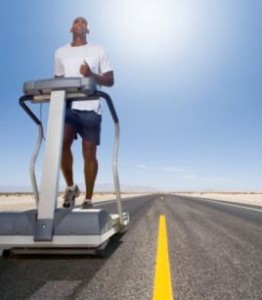 If on the whole you make the effort to eat healthy and have an effective exercise regime, you are likely to be concerned that any travel plans will derail this process. So here are some tips that will help you continue with your fitness programs even when you travel.
If on the whole you make the effort to eat healthy and have an effective exercise regime, you are likely to be concerned that any travel plans will derail this process. So here are some tips that will help you continue with your fitness programs even when you travel.
1. Do some homework before you leave. Check if the hotel that you plan to stay in has gym facilities or a pool and so on (depending upon your preferred workout activity).
2. Remember to pack workout clothes and shoes. This will remind you to work out and also make it convenient to hit the gym or simply head out for a walk wherever you are staying.
Workout shoes can be bulky so rather than carrying them in your baggage, you can simply wear them when you travel and instead pack the other less bulky shoes into your bag.
3. Carry a jump rope or a couple of dumbbells or kettle bells with you. A session with the jump rope can be a really strenuous workout in a short time, and doing a few weights with dumbbells or even lifting some bottles of bottled water can be a good workout.
4. Do other exercises that don’t need equipment – pushups, leg raises, squats, lunges and stair climbing are all easy to do wherever you are.
5. When eating out, order items that are steamed, grilled or poached. Avoid the items that are fried or calorie rich – if it says ‘crispy’ or ‘golden’, it’s probably been deep-fried, if it says ‘rich gravy or dressing’ that means high in calories too.
Also remember if it is a salad you’re ordering, ask for vinaigrette dressing rather than a cream or mayo-based one. Order small portions and opt for fruit instead of a confection at the end of the meal
—
Courtesy from FitnessHealthZone
June 3, 2011
Copy your Cat!
|
May 31, 2011
Are Americans Too Big To Drive Small?
Karen Steelman, a stay-at-home mom from Athens, Ga., has tried to like small cars. She read plenty of reviews, kicked their tires, and has even taken a few test drives.
But none of them make her feel safe. And none of them make her feel comfortable.
Steelman has a body mass index of about 37 – seven points above the obesity mark. She’s among a growing number of Americans who feel they are too big to comfortably drive a small car.
“I want to be environmentally friendly, but unless I am in an SUV these days … I find no pleasure or comfort in driving,” she says.
Automakers have long tried to figure out how to get Americans to buy smaller cars. But with obesity rates climbing, at least one analyst says there’s little point in trying.
Growing waistlines simply prevent a lot of U.S. drivers from feeling comfortable or secure in smaller cars. So, unless the entire country goes on a diet, says Dan Cheng, vice president and partner at business consulting firm AT Kearney, we may be destined to keep driving big cars no matter how much a gallon of gas costs in the future.
Cheng says the number of light trucks – a segment of the car market that includes SUVs, minivans, and pickup trucks – has increased steadily since the 1970s. And so has the percentage of adults in the U.S. who are classified as obese.
The number of obese people in the U.S. is expected to increase from 40% this year to about 43% in 2018, Cheng says. Cheng predicts that will keep almost half the population from even considering a small car except for purely economic reasons as small cars tend also to be cheaper than big cars or SUVs.
Calculating the “real” obesity rate in the U.S. is a little tricky. Cheng’s 40% rate is at the high end of estimates. The Center for Disease Control says the overall self-reported obesity rate in the U.S. is 26.7%, with nine states reporting obesity rates over 30%. In any case, the rate is nowhere close to the 15% rate the CDC considers to be a healthy obesity rate.
Small cars have made up 22.6% of the U.S. car market so far this year. Back in 2008, small car sales made up about 28% of the market, back when gas spiked over $4 a gallon.
Smaller cars and alternative fuels are critical to President Obama’s plan to reduce the nation’s dependence on foreign oil. The President last week promised to cut oil imports by a third by 2025. To do that, the country will have to slash its petroleum use.
First Lady Michelle Obama has made fighting childhood obesity one of her public service missions, but so far no one in the Obama Administration has made the connection.
Virtually All Cars and SUVs are Becoming Much More Fuel Efficient
Today’s SUVs and mid-sized sedans and crossovers are becoming more fuel efficient than their predecessors of a decade ago. But it’s smaller cars, which tend to be the most fuel efficient of all because they are smaller and lighter, that are critical to automakers meeting toughening fuel economy standards imposed by Congress.
Automakers have to meet a Congressionally mandated fleet average of 35 mpg by 2016.
Some of the most fuel-efficient small vehicles on the road get over 40 mpg, like the Ford Fiesta. The most fuel-efficient pickup truck is the Ford Ranger, and it gets 24 mpg, according to the government site fueleconomy.gov. A new Kia Rio, debuting this fall, will also be above 40 mpg when certified by the EPA. But neither of these vehicles was especially designed to accommodate widening waistlines.
Ironically, there are a few small cars that are designed to be extra roomy inside making them noteworthy for their interior spaciousness, if not for exceptional fuel economy. The Honda Fit, Nissan Cube and Versa, and Scion xBall have ample space up front, with good headroom and comfortable space for the driver. The Volkswagen Beetlehas long been a favorite among large people because of its easy egress and excess headroom.
Of those cars, only the Fit and Versa get above 30 mpg, and only just barely. In order for automakers to reach a 35 mpg fleet average by 2016, automakers need to boost those ratings closer to 40 mpg.
The most fuel efficient compact SUVs — the Hybrid versions Ford Escape, Mercury Mariner and Mazda Tribute — get 32 mpg. Their non-hybrid versions get 25 mpg.
Resources For the Future, a Washington D.C. think-tank that explores environmental and energy issues, says they’ve found a link between obesity and large vehicle sales, too. They say policies that reduce obesity can also reduce fuel consumption, because smaller people drive smaller cars.
Automakers like Ford are trying to design interiors that keep the bigger population comfortable. Elizabeth Baron, Ford’s technical specialist for virtual reality and advanced visualization, says the automaker has recently updated its database of model human sizes to incorporate the growing number of obese adults.
Automakers Looking at Console and Roofline To Make More Room
To keep drivers comfortable, her team focuses on a few key areas: The center console, seat controls on the left, and head room. If the center console is too large, it can press into peoples’ bodies. And the storage space in the console can be awkward for larger people to use. Seat controls can also be difficult to reach. Also, because obese drivers sit higher in their seats, they often feel squeezed if the roof line is too low. Automakers also need to be aware of where they place sunroof controls, because those can get in the way.
Robert Dean Cole, from Kenosha, Wis., is 6 foot 7 inches and 240 pounds, and his six-year-old son is nearly 5 feet tall.
“Obviously, little cars are not going to be in our future,” he says.
While he’d like to own a car with better gas mileage, he says he can barely fit behind the steering wheel in most of them.
“And even if I could actually fit under the steering wheel of the car my next worry would be surviving a car accident,” he says. “Good chance I won’t be surviving due to my size.”
So he recently purchased a Ford F-150 – one of the biggest vehicles in the U.S. It is also the most popular.
Jake Fisher, senior engineer at Consumer Reports, thinks it’s more that fear of being crushed that keeps most people away from small cars. Fisher has recently been test-driving a Fiat 500 for Consumer Reports, and he can fit his entire family in the car comfortably. They’ve enjoyed using it for around town.
But out on the highway, when they encounter some trucks, being in the small can feel a bit sketchy, he says. “When you drive up next to a Suburban, it’s a little intimidating,” Fisher says.
Consumer Reports, in fact, last year came out with a list of “Best Cars for Larger Drivers,” to spotlight their recommendation to auto companies to redesign seats and seat-belts for reasons of both comfort and safety. The consumer advocacy organization, which tests cars, recommended several cars for their roomy driver position and easy access. AOL Autos Editors augmented that list with a few selections and can be seen in the gallery below.
Still, because SUVs have been so popular for so long, many consumers won’t consider small cars out of fear they will come up on the short end of a one-on-one collision with one. Also, auto designers say many drivers, especially women, have come to like the elevated, commanding seating positions that come with SUVs. This attitude is especially prevalent in rural markets where pickups and SUVs make up a larger percentage of overall vehicles than in the cities and suburbs.
But the idea that bigger is safer is often not true. Many small cars get as good or better crash ratings than larger vehicles because automakers have engineered many safety features into small cars precisely to make up for their lack of mass in a collision with a larger vehicle. The 2011 Ford Fiesta has a 4-star crash rating from the Federal government, as listed at www.safecar.gov, the same as the Ford F-150 pickup truck, and better than some larger corossovers and SUVs like the Toyota RAV4 (which gets 3-Star). The Scion TC, built by Toyota and a small car, earned a 5-star rating.
It’s important to research each car under consideration for purchase because size of vehicle doesn’t always tell the whole safety story. But the vehicle does need to fit in the first place when a customer sits behind the wheel.
Bottom Line
A vehicle needs to fit its occupant, and clever design and engineering can overcome size limitations. As any large person who has test driven cars can attest, the Honda Fit and VW Beetle are roomier for the driver than some larger vehicles like Ford Taurus or Nissan Maxima.
Automakers under pressure to achieve better fuel economy across their lineup may need to give greater consideration to making small cars more comfortable for average Americans. Those that place sleek design over practical will lose customers and consideration.
April 30, 2011
Tall, obese men at higher risk for blood clots
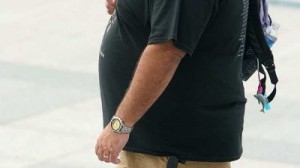
Tall men, especially if they are obese, are at a greater risk for blood clots than shorter, normal-weight men, suggests a new study. (AFP / Getty Images / April 29, 2011)
Tall and obese men appear more likely to develop venous thromboemoblism, which can lead to a potentially lethal blood clot in the lungs, according to a study published Thursday.
Researchers from the University of Tromso in Norway analyzed height and weight data from 26,714 people and assessed the incidence of venous thromboembolism over 12-1/2 years. In that time, 461 people developed the condition, in which a blood clot (or thrombosis) forms in a deep vein, usually in the thigh, and can move into an artery in the lung. Here’s a basic explanation of the condition fromPatient Health International and a detailed look, including risk factors, from Cleveland Clinic.
In the lung, the clot (called a pulmonary embolism) blocks blood supply and can lead to death. The American Heart Assn. offers this look at venous thromboembolism incidence and fatality statistics.
It begins: “Venous thromboembolism occurs for the first time in about 100 per 100,000 persons each year in the United States. About one third of patients with symptomatic VTE manifest pulmonary embolism, whereas two thirds manifest deep-vein thrombosis alone.”
The new research suggests that being either obese or tall, or the combination, puts men at greater risk for the condition compared to short (5 feet 7.7 inches or shorter), normal-weight men. Men who were obese and taller than 5 feet 11.7 inches were at fivefold greater risk of a blood clot, and men who were tall but of normal weight had a 2.6 times greater risk. Short, obese men had a 2.1 greater risk than short normal-weight men for a blood clot.
Yes, women too: Obese women, short or tall, had a slightly greater risk of a blood clot, scientists reported in Arteriosclerosis, Thrombosis, and Vascular Biology. Tall normal-weight women didn’t have increased risk.
Obesity is already a well-known risk factor for deep-vein thrombosis, but researchers aren’t sure why tall people would be more prone to such clots. The lead author of the study, Sigrid Braekkan, offers an explanation in a press release:
“In tall people the blood must be pumped a longer distance by the calf-muscle pump, which may cause reduced flow in the legs and thereby raise the risk of clotting,” Braekkan said.
There’s nothing a man can do about his height, so researchers say big men – and short ones, of course — should try to stay slim.
In the meantime, here are a few tips for preventing blood clots from the Agency of Healthcare Research and Quality:
— Don’t remain sedentary for more than an hour.
— On plane trips, get up from your seat and move around.
— Try not to cross your legs
— Wear loose-fitting clothing
— Reduce salt in your diet
And here are some tips from the same agency on preventing venous thromboembolsim in the hospital. There, it’s the most common cause of preventable death.
April 15, 2011
7 Breakfast Foods to Swap In, Not Out
Is breakfast really the “most important” meal of the day? Maybe, at least that’s what they told us in health class.
So if breakfast is the first meal of the day and you’re trying to lose weight, it’s probably a smart idea to make your first meal a good one.
And since most dieters judge food by two simple factors: fat and calories. Here are seven foods you should ditch and seven foods you should switch to if you’re looking for a better breakfast.
English Muffin or Bagel?

Sorry, but a bagel with a schmear of cream cheese just isn’t Kosher – at least not for dieting. You’re better off switching to toasted nooks and crannies dripping with melted butter.
*English Muffin, with butter
5.8g total fat
189 calories
Bagel, with cream cheese
8g total fat
436 calories
Apple or Banana?

Let’s face it, both apples and bananas are awesome – probably the healthiest foods on this list – but, if you’re looking to cut calories, go with the apple.
*Apple
0.17g total fat
50 calories
Banana
0.33g total fat
100 calories
Blueberry Yogurt or Oatmeal?

Even without the “probiotics,” eating a light yogurt is smarter than a bowl of old fashioned oatmeal.
*Dannon Light’n Fit Blueberry Yogurt (6oz)
0g total fat
80 calories
Old Fashioned Quaker Oats, with water (1/2 cup)
3g total fat
150 calories
Coffee with Skim Milk or 2% Milk?

For most people, missing their morning coffee is grounds for murder. So please, drink up! But make sure you stick with non-fat milk, not 2%
*Starbucks Coffee, with non-fat milk (short)
0g total fat
35 calories
Starbucks Coffee, with 2% milk (short)
2g total fat
50 calories
Wheaties or Raisin Bran?

One cereal uses professional athletes to push product. Another is peddled by the sun. The sports stars win, go with a bowl of Wheaties.
*Wheaties (1 cup)
1g total fat
110 calories
Raisin Bran (1 cup)
1.3g total fat
190 calories
Turkey Bacon or Pork?

It isn’t real bacon – it might not even taste like it – but the fat and calories don’t lie. Spare a pig, eat a turkey!
*Butterball Bacon-Style Turkey (1 slice, 18g)
3g total fat
40 calories
Pork Bacon (3 slices, 19g)
7.9g total fat
103 calories
Grapefruit Juice or Orange Juice?

Grapefruit juice might not taste as sweet, but choke it down. It’s better than orange juice. And when you drink grapefruit juice, it’s less likely to squirt in your eye.
*Tropicana Grapefruit Juice (8 fl oz)
0g total fat
90 calories
Tropicana Orange Juice (8 fl oz)
0g total fat
110 calories
April 8, 2011
“Vegetarian” Diets Reduce Heart Risks
 Eating a meat-free diet may lower your risk of developing heart disease, suggests a new study, helping to lessen the likelihood of metabolic syndrome.
Eating a meat-free diet may lower your risk of developing heart disease, suggests a new study, helping to lessen the likelihood of metabolic syndrome.
Metabolic syndrome is a collection of diseases that contribute to cardiovascular disease, including diabetes, obesity, and high blood pressure.
Researches found vegetarians had better blood sugar, blood fat, blood pressure, waist size, and body mass measurements than non-vegetarians.
In the study, 23 out of every 100 vegetarians were found to have at least three metabolic syndrome factors, compared with 39 out of every 100 non-vegetarians and 37 out of every 100 semi-vegetarians.
For the study, published in the journal Diabetes Care, scientists analyzed the diet of three different groups of people: vegetarians, non-vegetarians, and semi-vegetarians; in total, more than 700 adults.
The researchers used a questionnaire to obtain information on participants’ eating habits. People were classified as vegetarian, eating meat less than once a month; semi-vegetarian, eating meat less than once a week; and non-vegetarians. However, the term “vegetarian” is incorrectly defined; true vegetarians never eat meat.
Results showed vegetarians had an average body mass index (BMI) of 25.7. Unlike non-vegetarians who had an average BMI close to 30. Semi-vegetarians’ BMI fell between the vegetarians and non-vegetarians.
A BMI between 25 and 29 is considered overweight and a BMI from 30 and up is obese. Normal weight is between 18.5 and 25.
The findings remained steady when researchers combined all the readings to determine the risk of metabolic syndrome.
In 2008, Vegetarian Times reported that 7.3 million Americans follow a vegetarian diet: 59% are female, 41% are male. As of 2009, the total U.S. population was nearly 308 million.
According to the American Heart Association, a vegetarian diet – with its heavy vegetable consumption and low intake of saturated fat from animal products – has been shown to reduce the risk of heart disease, heart attack, obesity, high blood pressure, and some forms of cancer.
Article courtesy from diet-blog
Image courtesy from first reason blog
